
The Washington Metro, often abbreviated as the Metro and formally the Metrorail, is a rapid transit system serving the Washington metropolitan area of the United States. It is administered by the Washington Metropolitan Area Transit Authority (WMATA), which also operates the Metrobus service under the Metro name. Opened in 1976, the network now includes six lines, 98 stations, and 129 miles (208 km) of route.

Silver Spring station is a train station on the Red Line of the Washington Metro and the Brunswick Line of the MARC Train commuter rail system. The Metro station averaged 4,536 daily riders in 2023, making it the 19th-busiest stop in the network and the busiest in the state of Maryland. Trains travelling south from the station quickly cross the border into Washington, D.C., while northbound trains head underground and make their way further into Montgomery County.

West Falls Church station is a Washington Metro station in Idylwood, Virginia on the Orange Line, the first station inside the Capital Beltway on the Orange Line going east. It is one of only two stations in the system to have three tracks, the other being the National Airport station. The center track is used for storage and relaying trains to the adjacent Falls Church Yard.

Huntington station is an island-platformed Washington Metro station in the Huntington area of Fairfax County, Virginia, United States. The station was opened on December 17, 1983, and is operated by the Washington Metropolitan Area Transit Authority (WMATA). Serving as the southern terminus for the Yellow Line, the station is built into a hillside; the south mezzanine, along with escalator access, is accessible via an incline elevator.

Greenbelt station is a Washington Metro and MARC station in Prince George's County, Maryland. The station is the northeastern terminus of the Green Line of the Washington Metro. MARC commuter rail trains on the Camden Line also stop at Greenbelt on a set of tracks parallel to the Metro tracks.

SmarTrip is a contactless stored-value smart card payment system managed by the Washington Metropolitan Area Transit Authority (WMATA). The Maryland Transit Administration (MTA) uses a compatible payment system called CharmCard. A reciprocity agreement between the MTA and WMATA allows either card to be used for travel on any of the participating transit systems in the Baltimore-Washington metropolitan area. Unlike traditional paper farecards or bus passes, SmarTrip/CharmCard is designed to be permanent and reloadable; the term "SmarTrip" may refer to both payment systems unless otherwise noted.

The Washington Metropolitan Area Transit Authority, commonly referred to as Metro, is a tri-jurisdictional public transit agency operates transit service in the Washington metropolitan area. WMATA provides rapid transit service under the Metrorail name, fixed-route bus service under the Metrobus brand, and paratransit service under the MetroAccess brand. In 2023, the system had a ridership of 239,741,800, or about 844,000 per weekday as of the third quarter of 2024.

Metrobus is a bus service operated by the Washington Metropolitan Area Transit Authority (WMATA). Its fleet consists of 1,595 buses covering an area of 1,500 square miles (3,900 km2) in Washington, D.C., Maryland, and Virginia. There are 269 bus routes serving 11,129 stops, including 2,554 bus shelters. In 2023, the system had a ridership of 103,438,600, or about 393,300 per weekday as of the third quarter of 2024.

TheBus is a bus transportation system serving Prince George's County, Maryland, providing Monday-Saturday service. There are 29 bus routes, with most operating between Washington Metro stations in the county, with two routes running to Upper Marlboro. The fare is $1.25, but seniors, the disabled, one child under five years old, and students ride free. On October 13, 2008, TheBus began accepting payment using SmarTrip regional farecards. The county has contracted operations and maintenance of THE BUS system to RATP Dev. In 2023, the system had a ridership of 2,129,000 or about 8,200 per weekday as of the third quarter of 2024.

The Metro Transit Police Department (MTPD) is the transit police agency of the Washington Metropolitan Area Transit Authority (WMATA), created by the WMATA Compact on June 4, 1976.

Washington, D.C. has a number of different modes of transportation available for use. Commuters have a major influence on travel patterns, with only 28% of people employed in Washington, D.C. commuting from within the city, whereas 33.5% commute from the nearby Maryland suburbs, 22.7% from Northern Virginia, and the rest from Washington, D.C.'s outlying suburbs.

A passenger information system, or passenger information display system, is an automated system for supplying users of public transport with information about the nature and the state of a public transport service through visual, voice or other media. It is also known as a customer information system or an operational information system. Among the information provided by such systems, a distinction can be drawn between:

The 14th Street Line, designated Routes 52, 54, is a daily bus route operated by the Washington Metropolitan Area Transit Authority between Takoma station of the Red Line of the Washington Metro and L'Enfant Plaza station (52) of the Blue, Yellow, Orange, Green, and Silver lines of the Washington Metro or Metro Center station (54) of the Red, Blue, Orange, and Silver Lines of the Washington Metro. Some trips terminate at 14th Street & Colorado Avenue NW.

Metroway is a bus rapid transit (BRT) line operated by the Washington Metropolitan Area Transit Authority (WMATA) as part of their Metrobus system. It consists of a single line operating in Arlington and Alexandria, Virginia. It opened on August 24, 2014. It was the first bus rapid transit line to open in Virginia and in the Washington metropolitan area.

Apple Maps is a web mapping service developed by Apple Inc. As the default map system of iOS, iPadOS, macOS, and watchOS, it provides directions and estimated times of arrival for driving, walking, cycling, and public transportation navigation. A "Flyover" mode shows certain urban centers and other places of interest in a 3D landscape composed of models of buildings and structures.
Flash BRT is a bus rapid transit network in Montgomery County, Maryland with two operational lines and four more under development.

This is a roster of the bus fleet of Metrobus, the fixed-route bus service run by the Washington Metropolitan Area Transit Authority in Washington, D.C.
The College Park–North Bethesda Line, designated Route C8, is a bus route that operates Monday to Saturday that is operated by the Washington Metropolitan Area Transit Authority, United States, between College Park–University of Maryland station of the Green Line and North Bethesda station of the Red Line of the Washington Metro. The line operates every 30 minutes at all times. Trips are roughly 70–80 minutes long.

The Georgia Avenue Limited Line, designated as Route 79, is a daily bus route that is operated by the Washington Metropolitan Area Transit Authority between Silver Spring station of the Red Line of the Washington Metro and Archives station of the Green and Yellow lines of the Washington Metro. The line operates every 10–12 minutes at all times. Trips are roughly 50 minutes. This line provides additional express service for route 70 daily between 6:00 AM and 9:00 PM, serving select stops along Georgia Avenue.



















